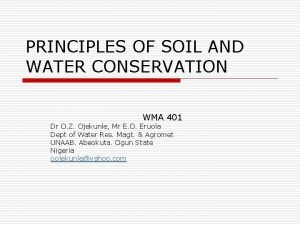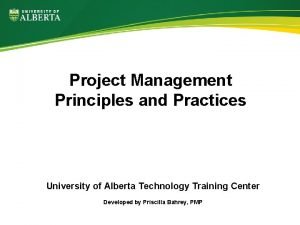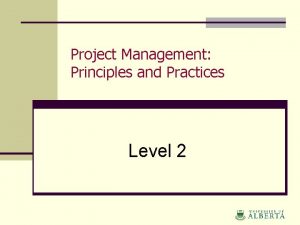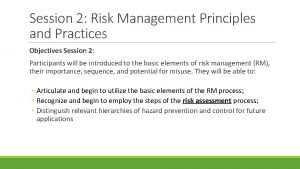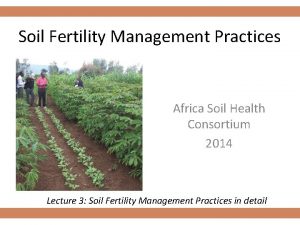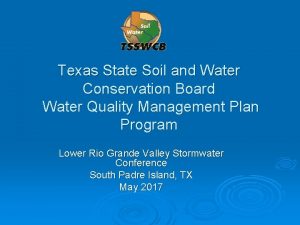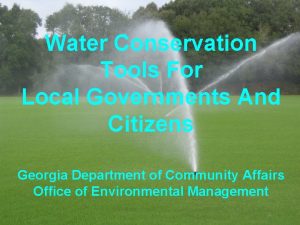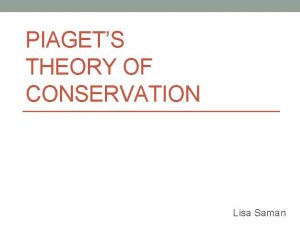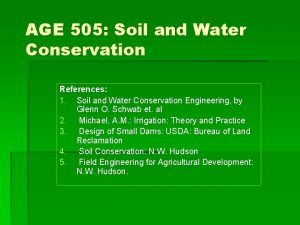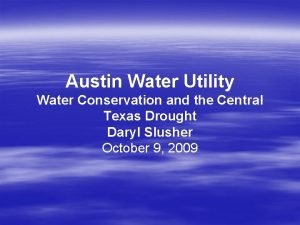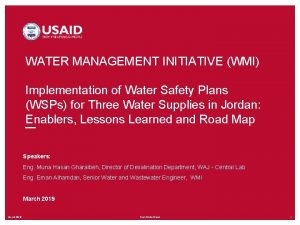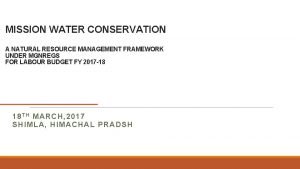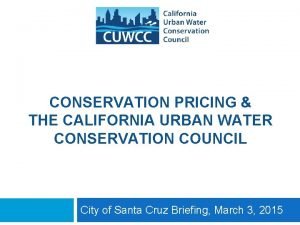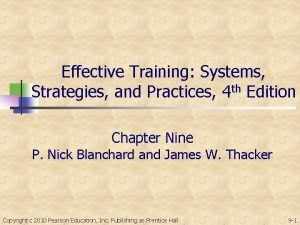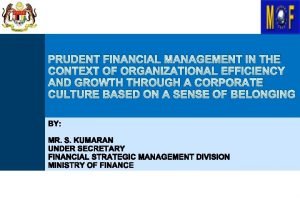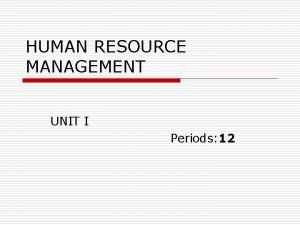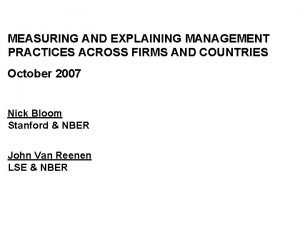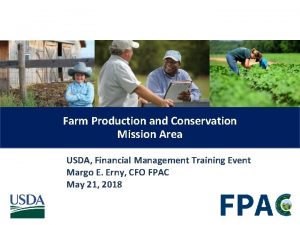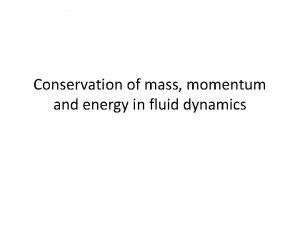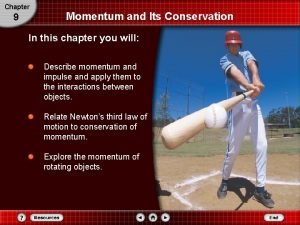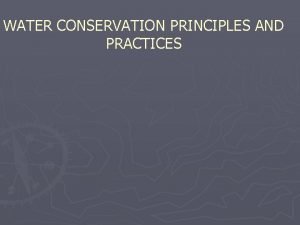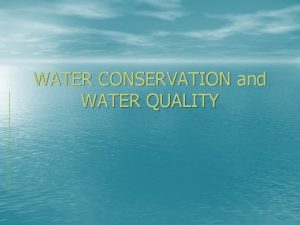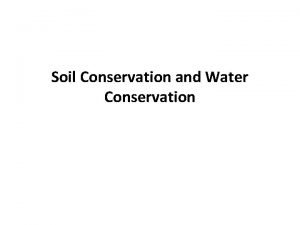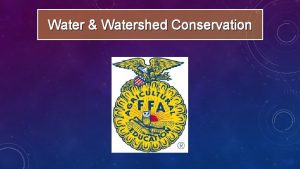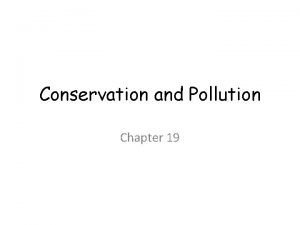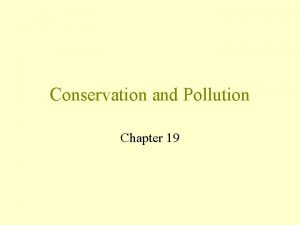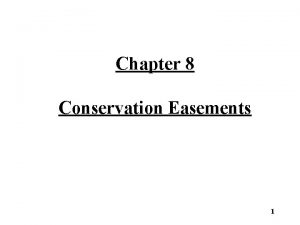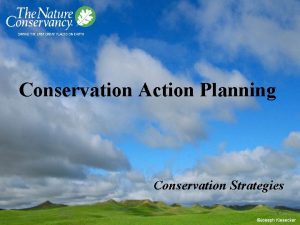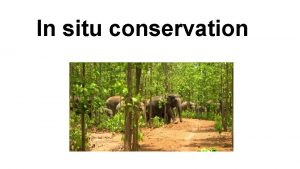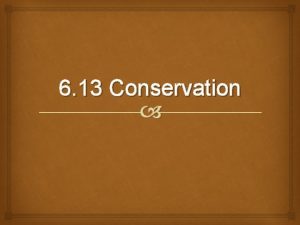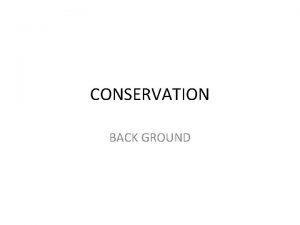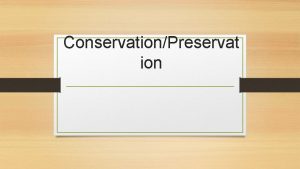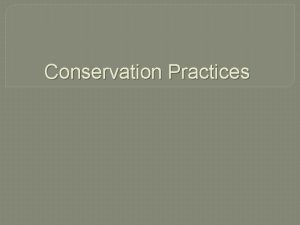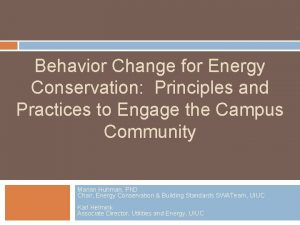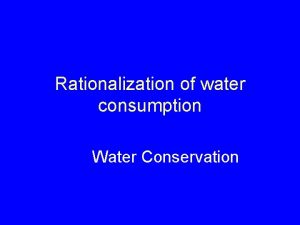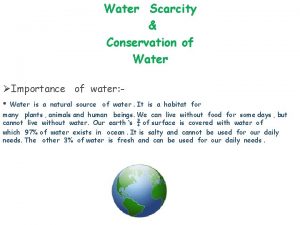WATER CONSERVATION PRINCIPLES AND PRACTICES Water conservation The






















































































































- Slides: 118

WATER CONSERVATION PRINCIPLES AND PRACTICES

Water conservation “The conservation treatment meant to reduce or prevent erosion while achieving the desired moisture conservation and/or runoff disposal. ”

Important principles n n n Increasing the time of concentration and thereby allowing more runoff water to be absorbed and held in the soil profile. Intercepting a long slope into several short ones, so as to maintain less than a critical velocity for the runoff water; and Protection against damage owing to excessive runoff.

Practices for water conservation Engineering measures: Hillside ditches q Bench terraces q Stone walls n Broad-based terraces q

Engineering measures Hillside ditches A series of shallow ditches built along the contour lines of a hill side slope at proper interval

Objectives n To break up a long slope into several short slopes, in order to intercept runoff water n The ditches may also serve as farm paths to facilitate transportation that the operating cost may be reduced.

Bench terraces n. A series of level or nearly level platform built along the contours at suitable intervals.

Objectives n To intercept runoff and control soil erosion. n To make cropping operations possible and safe on crop slope land.

Stone walls n Using stones to construct at a suitable spacing on crop land along contour lines

OBJECTIVES n n n T makes good use of rocks and stones existing on slopes, thereby clearing the land for cultivation. . to reduce soil and water losses and to trap the soil washed down from above, thus gradually building up bench terraces and hillside ditches in later years. To minimize the gradient of a slope to facilitate cultivation, mechanized operations and soil conservation


Broad based terraces A series of shallow, broad based terraces constructed on gently sloping land at a suitable spacing along the contour lines.

Objectives n To break the length of a slope to control soil erosion n To conserve soil moisture so as to help crop growth.

Grass planting on hill side ditches n The establishment of specific grasses on hillside ditches, including both bottom and side slopes of each ditch.

Objectives n To stabilize the hillside ditch and thus reduce maintenance cost. n To save the labor costs of weeding. n To prevent soil erosion on the upper side slope of the ditch and to gradually reduce the slope as sliding soil is trapped by the grass.

Agronomic and vegetative measures n. Contour planting n. Grass planting on hillside ditches n. Planting grass on risers of terraces n. Cover crops

n. Grass barriers n. Mulching Green manure n. Windbreaks

Agronomic and vegetative measures Contour planting: Plowing, furrowing and planting along the contour lines of a slope.


Objectives n To increase water penetration into soil and conserve soil moisture n To control runoff and soil erosion.

Planting grass on risers. The planting of suitable grasses on the risers of bench terraces. Objective. To prevent soil erosion from the risers and to maintain the stability of the terraces.

Cover crops n Plants which are grown to cover the surface of the ground with dense foliage, to control soil erosion and improve the soil.

Objectives To protect the surface of the soil from splashing of rain drops. n To built up soil organic matter n To suppress weed growth and surface management cost. n To minimize changes in micro-climate and in soil temperature, thereby providing a better environment for crop growth. n

Green manure. n A green manure crop is grown specially to improve soil and act as a fertilizer. It is plowed into soil while still green, or shortly after it matures

Objective To increase organic matter and nutrients in the soil, and to improve the physical and chemical characteristics of soil to increase the resistance of soil to erosion.

Grass barriers n Contour planting of suitable spaced strips of grass on slope land.

Objectives To arrest runoff so as to reduce soil and water losses and to hold soil and prevent it from being washed downhill. n To reduce the slope of a hillside cultural practices and mechanical operations. n To gradually convert the barriers into bench terraces n

Windbreaks. . Strips of trees or tall grasses planted at appropriate intervals to prevent or reduce wind erosion and crop losses caused by wind.

Objective n To control wind erosion n To reduce physiological or mechanical injuries to crops caused by strong winds. n To reduce evapotranspiration n To reduce salt damages if the locality is near the area.

Objective To arrest runoff so as to reduce soil and water losses and to hold soil and prevent it from being washed downhill. n To reduce the slope of a hillside to facilitate cultural practices and mechanical operations. n To gradually convert the barriers into bench terraces. n

Drainage Diversion ditches: A ditch constructed approximately along the contour of a slope for the purpose of intercepting surface and diverting it to a suitable outlet.

Objectives. n To protect farmland buildings by diverting runoff from hill slopes. n To control gully erosion.

Drainage ditches Drainage channels running along a slope, which are lined with stone, brick, or concrete etc.

Objectives n To ease the flow of runoff water and to protect the ditch from erosion. n To gather water flow in hillside ditch and contour drainage channels, and carry the flow to a safe place to be discharged.

Grassed water ways. n Earth waterways planted with grasses to control soil erosion.

Objectives To provide safe outlet for runoff water. n To prevent soil erosion and to stabilize waterways. n To facilitate the operations of farm machinery. n To maintain a stable field environment. n

CONTOURING

DEFINITION n Plowing, furrowing, and planting along the contour lines of a slope. n It is a tillage practice of plowing the land in slopy areas across the slope. n Not along the slope.

PROBLEMS OF SLOPY AREAS n there are two main problems in slopy areas related to crop growing n Water conservation n Soil erosion

OBJECTIVES n To increase water penetration into the soil. n To conserve soil moisture. n To control run off. n To control soil erosion.

APPLICATION n This practice should be adopted where ever cultivated crops are grown on slope land.

OPERATIONAL PROCEDURE n When hilly side ditches broad-based terraces or stone walls exists, they should be used as guidelines for plowing, furrowing and other cultivational operations. n The most adequate number of long rows along the guidelines is 4 -6. n Short rows should be positioned in the middle between two guidelines.

CONTOUR STRIP CROPPING n n In this continuous row crops are replaced by strips of row crops and alternating with strips of forage crops. Row crop strips must be sized to minimize run off, soil erosion. Forage strips must be wide enough to slow and filter the run off. Erosion reduction is about 50% greater than with comentional contour planting.

NOTE n This conservation practice is more popular than terracing for slopes because of its lower cost for erosion control. n Contour farming can reduce soil loss by 50% on slopes of 2 -8% and not more than 300 ft. Long.

Terracing Piece s of land at the same elevation are separated as an independent field water stay in it. When water level reach higher in one piece of land then it will moves down.

Terracing is a soil conservation practice applied to prevent rainfall runoff on sloping land from accumulating and causing serious erosion. Terraces consist of ridges and channels constructed across-the-slope.




Earliest form of Terracing n The field is supported by walls constructed across a narrow valley, which were originally occupied by an intermittent stream. The agricultural areas of these territories are usually level allowing water to drain into the reservoirs from around the surrounding slopes. The terrace’s effectiveness, durability and design suggests that this was the earliest form of terracing in the New World.


Types of Terraces n Bench terraces n Contour terraces n Parallel terraces

Bench Terraces A shelf-like embankment of earth, usually man-made, along a contour of sloping land to control runoff and erosion Bench terraces reduce land slope and allow run-off from the upper side of the terrace to go into a lower portion where it spreads out and infiltrates.



Contour Terraces Contour terraces with their point rows and grassed waterway outlets, that follow the lay-of-the-land. contour terraces may have level channels to collect and hold the water until it seeps into the soil.

contour terrace system with many point rows and grassed waterways


Parallel Terraces n parallel terraces are constructed parallel to each other. Parallel terraces eliminate the production losses associated with point rows and minimize interference to farming operations when spaced at multiple widths of planting and harvesting equipment.

A parallel terrace system.


Parallel tile outlet terraces n Terraces that are constructed in parallel and discharging runoff through subsurface drains are known as parallel tile outlet terraces. With PTO terraces, water that accumulates behind a terrace ridge is discharged through a surface inlet into a subsurface drain. The surface inlet, called a riser, has a restricted section to control the discharge rate, causing some of the runoff to be temporarily stored.

Water temporarily stored behind a newly constructed PTO terrace.

Benefits of parallel tile outlet terraces. n n n The total area can be farmed, since grassed waterways are not needed. Peak discharges are reduced because runoff is temporarily stored. Sediment and other contaminants settle out behind the terrace ridge before polluting water in a receiving stream.

Benefits of Terrace System. q Conservation of soil and water. q Reduces the velocity of water. q Reduces soil erosion. q Increases the infiltration.

Terraces in controlling erosion. n n They intercept rainfall runoff as it starts down a slope, thus preventing a large accumulation of flow on the surface. This reduces the potential for sheet and rill erosion. Terraces also give soil particles that do erode a chance to settle out in the basin behind the terrace ridge, while the excess water is slowly discharged through a subsurface drain.

Terraces interfere with field operations. n Any permanently-installed practice will, to some degree, obstruct field operations and/or take some land out of production. However, these obstructions are greatly minimized under present methods of design. For instance, with a PTO terrace system, elimination of the grassed waterways more than offsets the interference caused by crossslope ridges and channels.

What field conditions terraces are best adapted. n Fields with long, fairly-uniform slopes that are not too steep (generally less than 8 percent) are best adapted to broad-based terraces. If the slopes are very irregular or if the soil is shallow (less than 6 inches), alternative method should probably be used.

n In some cases, on land where a total terrace system is not practical, terraces are sometimes placed across minor watercourses. This type of terrace uses subsurface outlets similar to PTO terraces. It controls sediment discharge but does not check soil erosion as effectively, since steep slopes are likely to exist above the terrace.

BENCHING (BENCH TERRACES)

BENCHING n It is converting a steep slop into a series of steps with horizontal or nearly horizontal ledge and vertical or almost vertical wall b/w ledges. n It is also called bench terrcing.


Bench terraces In various parts of the world bench terraces have been extensively constructed at great expenditure of labor in order to make stabilize sloping land. n Such structures consist nearly level benches that cross slope in the series of step like platforms. n


History n The practice bench terracing is almost as old as agriculture itself. n Centuries before people attained great skill in the construction of essentially level terraces that were supported by artificial walls of stone. n This structures were used extensively in the building of broad field in the valleys and establishing bench like strip on the mountain

Objectives n Reduce the run off. n Increase the infiltration rate. n Conserve the soil

Keep in mind n n Before bench terraces are constructed in any area, a thorough study should be made to justify that soil is favorable for cultivation. There are many parts of the world where bench terracing undoubtedly is going to be required sooner or later because the scarcity of favorable land.

n To hold a vertical face of some structural walls is necessary usually of stones or less frequently bricks of timber n In stable soils this wall may be hold by vegetation. n Large amount of labors required to construction of bench terracing

Bench terraces design to n Control the erosion by reducing the slop of the cultivated areas. n Make steep land available for cultivation. n To reduce the run off and increases the infiltration.

Bench terraces are constructed on a contour, to minimize run off. n The difficulty is to discharge any surface run off down slop without causing erosion. n When bench terraces are uses to cultivate crop, It is desirable for each bench to be wide as possible n

Step terraces n When regular cultivation is not required, as for tree crops, smaller bench terraces will be effectively and less earth moving, these are called step terraces and used for tree, tea, coffee and wines.


Irrigation bench terraces n n Some time flat bench terraces raised lip at the outer edge to retaine irrigation water. Extensively used for production of rice. The Banaue rice terraces in Philippines are magnificent example of irrigation bench. It also found mostly in Indonesia, China and Japan because their staple food is rice.


STRIP CROPPING n Crop planting in which wide rows of heavyrooted plants are alternated with loose-rooted plants so as to lessen erosion, as on a hillside

INTRODUCTION n Strip cropping is a very effective and inexpensive method for controlling soil erosion. Strip cropping is a combination of contouring and crop rotation in which alternate strips of row crops and soil conserving crops (sods) are grown on the same slope, perpendicular to the wind or water flow. When soil is detached from the row crops by the forces of wind or water, the dense soil conserving crops trap some of the soil particles and reduce wind translation and/or runoff

TYPES OF STRIP CROPPING n n n Contour strip cropping Wind strip cropping Permanent or temporary buffer strip cropping

COUNTER STRIP CROPPING n Contour strip cropping is the growing of a soil -exposing and erosion-permitting crop in strips of suitable widths across the slopes on contour, alternating with strip of soilprotecting and erosion-resisting crop.


WIND STRIP n It consists of planting tall-growing crops such as jowar, bajra or maize, and low-growing crop in alternately arranged straight and long, but relatively narrow, parallel strips laid out right across the direction of the prevailing wind regardless of the contour.

Evaluating Fields for Strip Cropping Each field should be evaluated to determine three factors: 1)Which crops can suitably be grown on the field's soils- -This largely depends on the depth of the rooting zone. n

THREE FACTORS n 2)The most effective surface water management system for the field-gully erosion can be prevented by establishing sod-based waterways in the naturally -occurring major drainage channels running down slopes of the field. Using practices such as surface residue management, minimum tillage or no-till, winter cover crops, and crop rotations, in addition to establishing strips, will reduce the risk of rill and sheet erosion.

THREE FACTORS 3)The specifications for strips to be used on the field. Ø Provide technical help in laying out strips to keep them of constant width. Ø Along the field contour.

Establishing Cropping Systems in Strips n Each strip should be viewed as a small, individual field, since many management decisions will be made on each strip or on groups of strips. Which crop rotation to use is probably the most basic of these decisions, since strip cropping will most likely involve growing at least two crops in some form of rotation among the strips. Although there are numerous possibilities for cropping systems, the following ones are the most common:

PROBLEM OF STRIP CROPPING n One of the most common problems encountered in strip cropping is maintenance of sod waterways. Care must be taken when applying herbicides to cut spray nozzles or spreaders off each time you go across a waterway. Otherwise, sod will likely be killed and have to be reestablished




MULCHING

MULCHING: It is protective cover provided to soil by tillage practices, grasses, crop residues or any other material, which is termed as mulch and this practice is known as mulching.

OBJECTIVES: 1 -To reduce runoff and soil losses. 2 -To suppress weeds and save labour cost. 3 -To reduce evaporation losses. 4 -To adjust soil temperature. 5 -To increase soil organic matter. 6 -To decrease direct impact of raindrop onto soil surface.

Types of Mulches: (1)Natural Mulch (2)Artificial Mulch (1)Natural Mulch: It is provided by tillage operation. crumb structure is made, capillary tubes are broken down. capillary pores are decreased. Upward rise of water is checked.

(2) Artificial Mulch: Materials like manures, straw, leaves, stubbles, special papers are used as an artificial mulch.

Sources of mulches: -Cover crops -Grasses -Litter -Fibrous material -Cotton netting -Paper netting -Polythene sheats

Problems of mulch tillage: -Anaerobic conditions in wet areas. -Nutrient movement. -Soil surface temperature. -Introduction of pest, pathogen. attack or disease problem. -May cause toxicity. -Not effective in poor drained areas. -Problems in weed control.

Solutions to overcome these problems: -To control pathogen infestation strip zone tillage can be used, it reduces wind and water erosion. -Chiesling instead of ploughing. -Adequate drainage is required.

Effects of mulching: PHYSICAL EFFECTS: -Direct impact of rainfall. -Splash erosion decreases. -Less depressions on surface soil. -Frequent freezing of soil. -Less accumulation of ice and water. -Decrease depth of frost penetration. -Aggregation of soil increases.

PHYSICAL EFFECTS: -Resistance to detachment by wind & water erosion. -Increase porosity and water holding capacity. -Increase percolation & infiltration. -Decrease runoff & evaporation. -Decrease wind velocity.

CHEMICAL EFFECTS: -Tie up of available N. Reduction of surface soil. - Affect the release of N. -Increase N fixation. -Increase of total potash but less availability. -Loss of nutrients by leaching.

BIOLOGICAL EFFECTS: -Increase microbial activity. -Larger population of insects, pathogen, rodents, pests. -Biological control measures can be used.

Watershed Management

Introduction Watershed “ is the land from which water drains into a particular stream, river, lake or other water body. ” All land (and all humans, wildlife, and activity on that land) are part of one watershed or another.

Watershed Management “is land management and restoration as it is about the river itself. Protecting and restoring rivers entails addressing pollution and wildlife habitat problems in the entire watershed, or the entire land area that drains to the river. ”

Principles of Watershed Management Ø Ø Ø Ø Utilizing the land based on its capability. Protecting top fertile soils Minimizing silting up of tanks, reserviors and lower fertile land In situ conservation of rain water Protecting vegetative cover throughout the year Water harvesting for supplemental irrigation Maximizing form income Improving infrastructural facilities for storage , transport and Agri. marketing.

Objectives of Watershed Management Ø Ø Ø Efficient use of land Flood control Adequate water supply Efficient use of natural resources Expansion of recreation facility

Steps in Watershed Management n Basic Information Ø Ø Ø Statistics of population and livestock Pattern of land ownership Topography Cropping System and Yield and land capability for farmer Data on Rainfall, Erosion problems and ground water Information on existing water resources Service faculties like school, banks , Market health, Veternary facilities

Developmental Components Ø Ø Ø Ø Soil Conservation Measures Runoff Harvest in storage structures and its recycling for protective irrigation. Improving fuel, fodder and horticulture through alternate land use systems Optimal land use with appropriate technology Ground water recharge and development Efficient use of available water Development of livesotck, poltry and other associated activities

Component of Watershed Management Programme Ø Soils and Water conservation Ø Water Harvesting Ø Crop management Ø Alternate land use system
 Water and water and water water
Water and water and water water Water conservation objectives
Water conservation objectives Sdlc principles and practices
Sdlc principles and practices Security program and policies principles and practices
Security program and policies principles and practices Security program and policies principles and practices
Security program and policies principles and practices Security program and policies principles and practices
Security program and policies principles and practices Security program and policies principles and practices
Security program and policies principles and practices Project management principles and practices
Project management principles and practices Broadcasting principles and practices
Broadcasting principles and practices Florida real estate principles practices & law
Florida real estate principles practices & law Project management principles and practices
Project management principles and practices Change management principles and practices
Change management principles and practices What are universal precautions milady
What are universal precautions milady Current issues in classroom testing
Current issues in classroom testing What is this
What is this Language assessment principles and classroom practices
Language assessment principles and classroom practices Risk management principles and practices
Risk management principles and practices Secure coding principles and practices
Secure coding principles and practices Bob tricker corporate governance
Bob tricker corporate governance Tourism: principles, practices, philosophies
Tourism: principles, practices, philosophies Florida real estate principles practices & law 43rd edition
Florida real estate principles practices & law 43rd edition 8 principles of evidence based practices
8 principles of evidence based practices Florida real estate principles practices & law
Florida real estate principles practices & law Florida real estate principles practices & law
Florida real estate principles practices & law Florida real estate principles practices & law 43rd edition
Florida real estate principles practices & law 43rd edition Example of no brokerage relationship
Example of no brokerage relationship Agronomic measures of soil and water conservation
Agronomic measures of soil and water conservation Texas soil and water conservation
Texas soil and water conservation Hát kết hợp bộ gõ cơ thể
Hát kết hợp bộ gõ cơ thể Bổ thể
Bổ thể Tỉ lệ cơ thể trẻ em
Tỉ lệ cơ thể trẻ em Voi kéo gỗ như thế nào
Voi kéo gỗ như thế nào Tư thế worms-breton
Tư thế worms-breton Bài hát chúa yêu trần thế alleluia
Bài hát chúa yêu trần thế alleluia Môn thể thao bắt đầu bằng chữ đua
Môn thể thao bắt đầu bằng chữ đua Thế nào là hệ số cao nhất
Thế nào là hệ số cao nhất Các châu lục và đại dương trên thế giới
Các châu lục và đại dương trên thế giới Công thức tính thế năng
Công thức tính thế năng Trời xanh đây là của chúng ta thể thơ
Trời xanh đây là của chúng ta thể thơ Mật thư anh em như thể tay chân
Mật thư anh em như thể tay chân Phép trừ bù
Phép trừ bù độ dài liên kết
độ dài liên kết Các châu lục và đại dương trên thế giới
Các châu lục và đại dương trên thế giới Thể thơ truyền thống
Thể thơ truyền thống Quá trình desamine hóa có thể tạo ra
Quá trình desamine hóa có thể tạo ra Một số thể thơ truyền thống
Một số thể thơ truyền thống Cái miệng bé xinh thế chỉ nói điều hay thôi
Cái miệng bé xinh thế chỉ nói điều hay thôi Vẽ hình chiếu vuông góc của vật thể sau
Vẽ hình chiếu vuông góc của vật thể sau Thế nào là sự mỏi cơ
Thế nào là sự mỏi cơ đặc điểm cơ thể của người tối cổ
đặc điểm cơ thể của người tối cổ Thứ tự các dấu thăng giáng ở hóa biểu
Thứ tự các dấu thăng giáng ở hóa biểu Vẽ hình chiếu đứng bằng cạnh của vật thể
Vẽ hình chiếu đứng bằng cạnh của vật thể Vẽ hình chiếu vuông góc của vật thể sau
Vẽ hình chiếu vuông góc của vật thể sau Thẻ vin
Thẻ vin đại từ thay thế
đại từ thay thế điện thế nghỉ
điện thế nghỉ Tư thế ngồi viết
Tư thế ngồi viết Diễn thế sinh thái là
Diễn thế sinh thái là Dot
Dot So nguyen to
So nguyen to Tư thế ngồi viết
Tư thế ngồi viết Lời thề hippocrates
Lời thề hippocrates Thiếu nhi thế giới liên hoan
Thiếu nhi thế giới liên hoan ưu thế lai là gì
ưu thế lai là gì Hổ sinh sản vào mùa nào
Hổ sinh sản vào mùa nào Sự nuôi và dạy con của hổ
Sự nuôi và dạy con của hổ Sơ đồ cơ thể người
Sơ đồ cơ thể người Từ ngữ thể hiện lòng nhân hậu
Từ ngữ thể hiện lòng nhân hậu Thế nào là mạng điện lắp đặt kiểu nổi
Thế nào là mạng điện lắp đặt kiểu nổi Water conservation tools
Water conservation tools Conservation age
Conservation age Preoperational reasoning stage
Preoperational reasoning stage Conservation of volume piaget
Conservation of volume piaget Water conservation project
Water conservation project Water conservation references
Water conservation references Water conservation in hotel industry
Water conservation in hotel industry Austin water rebates
Austin water rebates Water conservation project
Water conservation project Mission water conservation under mgnrega
Mission water conservation under mgnrega Water conservation project
Water conservation project California urban water conservation council
California urban water conservation council What is fresh water allowance
What is fresh water allowance Chlorination
Chlorination Best practices in d365 finance and operations
Best practices in d365 finance and operations Critical thinking and reflective practices
Critical thinking and reflective practices Code standards and practices 2 level ii lesson 3
Code standards and practices 2 level ii lesson 3 Chapter 36 emergency preparedness and protective practices
Chapter 36 emergency preparedness and protective practices Best practices of catholic pastoral and finance councils
Best practices of catholic pastoral and finance councils Work practices and attitudes
Work practices and attitudes Cultural representations and signifying practices
Cultural representations and signifying practices Effective training systems strategies and practices
Effective training systems strategies and practices Part two analyzing transactions in a cash control system
Part two analyzing transactions in a cash control system Big data: issues, challenges, tools and good practices
Big data: issues, challenges, tools and good practices Softeners for rigging
Softeners for rigging Chapter 10 section 1 the rise of islam
Chapter 10 section 1 the rise of islam Taoist practices and rituals
Taoist practices and rituals Prudent practices for organization growth and development
Prudent practices for organization growth and development Sikhism origin
Sikhism origin Restorative practices and pbis
Restorative practices and pbis Flipchart on safety practices and sports injury management
Flipchart on safety practices and sports injury management Chapter 36 emergency preparedness and protective practices
Chapter 36 emergency preparedness and protective practices Objective of hrm
Objective of hrm Hrmhrm
Hrmhrm Human resource management policies
Human resource management policies Eucharist quotes gcse
Eucharist quotes gcse Management practices across firms and countries
Management practices across firms and countries Soil conservation and domestic allotment act
Soil conservation and domestic allotment act Soil conservation and domestic allotment act
Soil conservation and domestic allotment act Define cyclic coordinates
Define cyclic coordinates Cyclic coordinates and conservation theorems
Cyclic coordinates and conservation theorems Chapter 11 physics study guide
Chapter 11 physics study guide Fpac business center org chart
Fpac business center org chart It environment management tools
It environment management tools A 120 kg lineman moving west
A 120 kg lineman moving west Mass momentum and energy conservation
Mass momentum and energy conservation A 1875 kg car going 23 m/s
A 1875 kg car going 23 m/s Chapter 56 conservation biology and restoration ecology
Chapter 56 conservation biology and restoration ecology Biological diversity and conservation chapter 5 answers
Biological diversity and conservation chapter 5 answers

